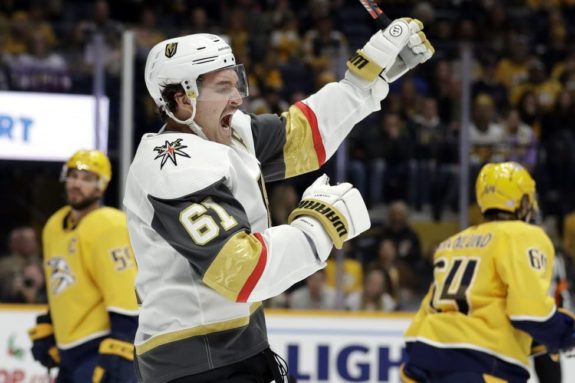The Vegas Golden Knights made it look easy in the 2017 Expansion Draft. Pick up an under-the-radar developing talent to break out? Check (William Karlsson). Negotiate your way into a treasure trove of picks and prospects? Check. Find a signature goalie and face of the franchise? Check (Marc-Andre Fleury). Go to the Stanley Cup Final in year one? Check.
In fact, the Golden Knights made it look so easy, there was probably too much expectation placed upon the Seattle Kraken, the newest expansion franchise, that there existed this easy-to-follow blueprint. Instead, Seattle has struggled out of the gate, an understandable fate for a first-year franchise but one that does further highlight how incredibly Vegas’s magical debut was.
So, where have GM Ron Francis and the Seattle Kraken gone wrong? Let’s take a look at what the Golden Knights did right that the Kraken have, to this point at least, been unable to replicate.
Goaltending
It was less expert management and more good fortune that allowed Fleury to fall into the laps of the Golden Knights in the 2017 Expansion Draft. The Pittsburgh Penguins were ready to transition to the younger Matt Murray and Vegas was happy to oblige, landing a three-time Stanley Cup champion as their starting netminder and the first face of the franchise while even netting a 2020 second-round pick for the trouble.

We all know how this one turned out. Even as he crept into his mid-thirties, Fleury was an essential component to a perennial playoff contender (Murray hasn’t fared as well). He sported a .917 save percentage and 2.41 goals-against average while winning 117 games across four seasons, helping the Golden Knights to five playoff series wins and a Stanley Cup Final appearance. Last season, the now-37-year-old finally won his first Vezina Award.
Joining Fleury as a finalist in last year’s Vezina race was Philipp Grubauer, the former Colorado Avalanche goaltender who joined Seattle this past summer as a free agent. He and Expansion Draft addition, Chris Driedger, were expected to give the Kraken an impressive one-two combination between the pipes, but both have struggled mightily with less talent in front of them. The tandem, along with third-stringer, Joey Daccord, have combined for a .874% save percentage and 3.50 GAA.
Opportunities for Youth
Fleury might have been the big name that Vegas landed in the expansion draft, but their central focus among skaters skewed a bit younger. George McPhee and the front office identified young, under-the-radar players who could earn playing time with the Golden Knights that they weren’t afforded on their former teams, enabling players like Karlsson, Erik Haula and Alex Tuch to thrive. All told, nine of their top 11 2017-18 leading scorers were 27 and younger.
That strategy has paid dividends that continue to this day, as Karlsson, Jonathan Marchessault, Reilly Smith and Shea Theodore remain key contributors. Notably, each of those players were acquired while still remaining somewhat cost-controlled, maintaining a flexible cap situation (at the time, anyway!) that allowed Vegas to later add superstar talent.

Perhaps feeling the pressure of following the Golden Knights’ lead, Seattle went the other way, adding more impact veteran talent in hopes of achieving immediate results. Of the Kraken’s 10 leading point-getters at the moment, only three (Jared McCann, Alex Wennberg and Vince Dunn) are under 28 years of age. That the team isn’t winning presently doesn’t bode well for the duration of their contracts, some of which run four more seasons beyond this one.
Maximizing Assets
It’s possible that the Golden Knights’ biggest advantage over Seattle simply came in being the first expansion club to operate under these terms. Four years after McPhee engineered 10 Expansion Draft trades wherein he acquired assets from panicked GMs for the promise not to select certain available players, Kraken GM Ron Francis was unable to land any similar side deals. Francis, himself, believes that other executives had smartened up in the interim.
“Vegas did a good job taking advantage of the rules and sort of everyone’s lack of experience in that environment,” said Francis after the Draft. “Last time, where GMs were more willing to, in a sense, overpay to protect certain assets. This time, they learned from that and they weren’t willing to make the mistakes that they made last time.”

(AP Photo/Mark Humphrey)
Those types of trades likely wouldn’t have helped this year, but they certainly would’ve made for a rosier long-term outlook. As of now, Seattle has just one additional fourth-rounder in the 2022 NHL Entry Draft and two acquired picks in 2023. Comparatively, Vegas accumulated 12 selections ahead of the 2017 Draft (Nicolas Hague remains, while others were flipped to add the likes of Mark Stone and Max Pacioretty) and made eight more picks in each of the next two.
You may also like
- 9 NHL Teams That Missed in Free Agency
- Golden Knights Will Miss Jonathan Marchessault
- Islanders’ Lamoriello Needs to Follow Golden Knights’ Ruthless Trade Model
- Golden Knights Struggling to Address Voids in Forward Corps
- Golden Knights Took Major Risk With 1st-Round Pick Trevor Connelly
If the Golden Knights’ instantaneous rise – both as a Stanley Cup finalist in their expansion season and as a perennial Cup contender built from scratch – wasn’t properly appreciated before, it certainly should be now. Seattle’s first year certainly hasn’t been all bad to date, but existing in Vegas’ shadow has made it seem that way. If they can build off of what they have, there’s still room for a more traditional expansion success story (from “Kraken notes: Success on special teams has translated into success in win column,” Geoff Baker, Seattle Times, 11/29/21).
